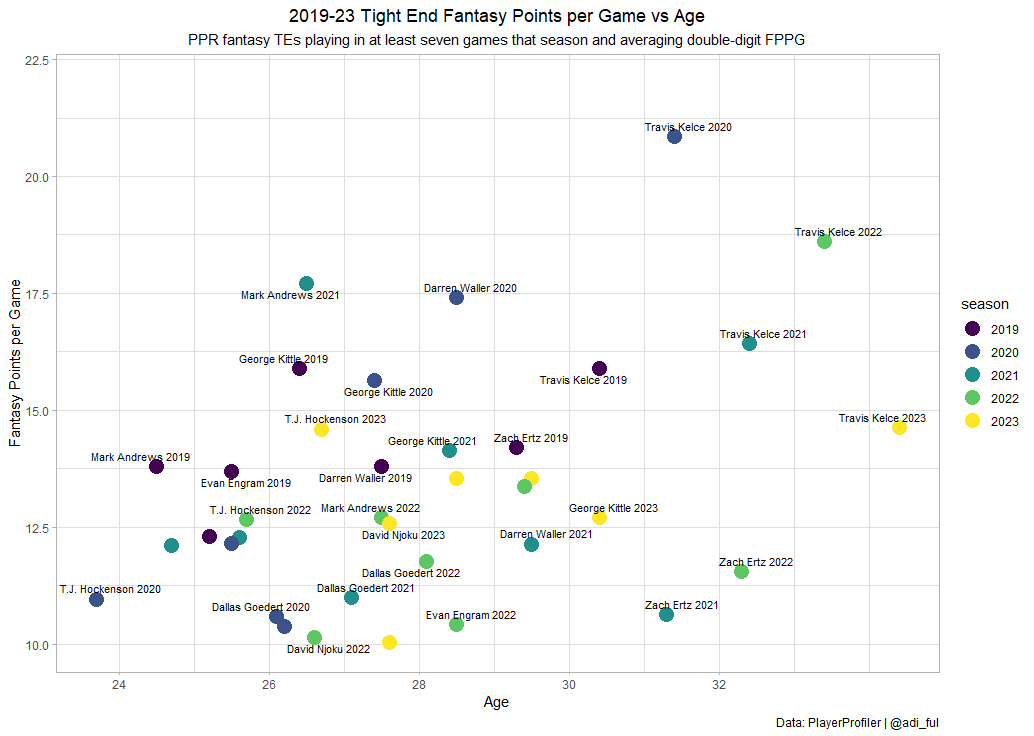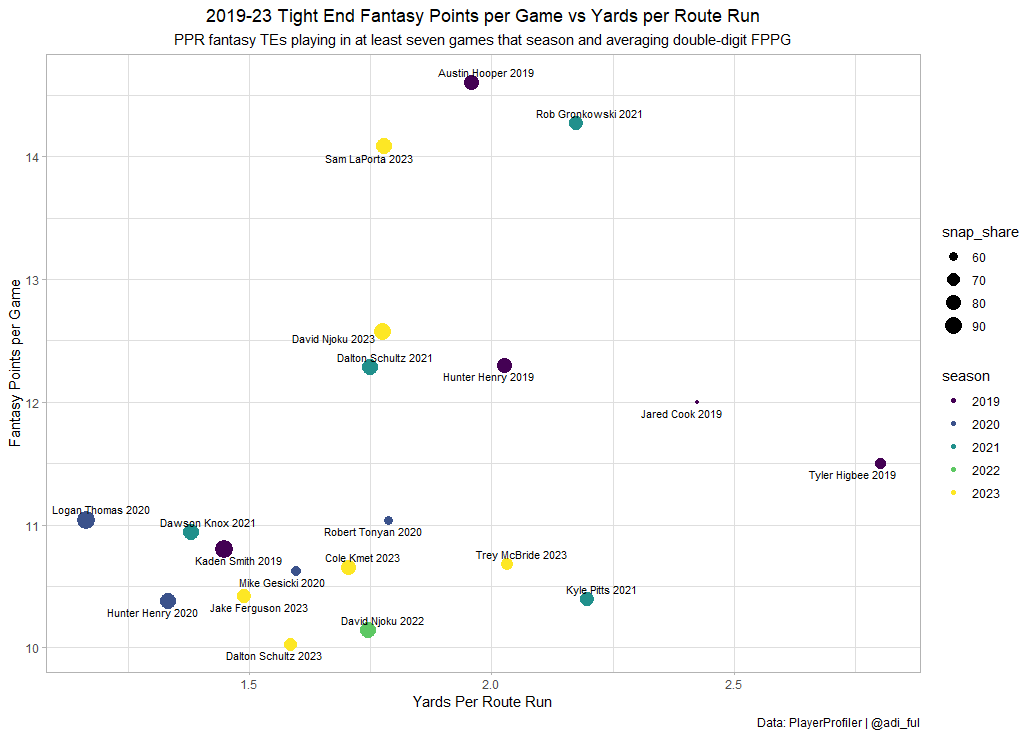PlayerProfiler is home to award winning dynasty rankings and tools. Our Dynasty Deluxe package includes complete Dynasty Rankings, Rookie Rankings, Trade Analyzer, Draft Planner, Mock Drafts, and more. Check it out. Below, Aditya Fuldeore examines the tight end position in fantasy football, scoring tendencies at the position and how to identify future breakouts for the highly volatile position.
Among the fantasy football position groups, tight ends are perhaps the most frustrating to project. Fantasy managers can barely find consistent top-eight options, let alone top-12. The elite dynasty tight ends like Travis Kelce and Mark Andrews have been at the top of the position for a while, but how can we project the next elite players at the position? Can tight end production be predicted based on trends? We dive into these questions in this latest dynasty strategy piece.
Can Tight End Production Periods Be Defined?
Among the 51 tight ends scoring at least 10 fantasy points per game over the last five seasons, they had an age variance of 8.63. This gives tight ends an almost-nine-year range of potential production. That’s twice the age range of RBs and over a year longer than WRs.

- Double-digit scoring tight ends from the last five seasons by age
While it seems like a potential age apex for TEs would come in later years, the data is skewed due to repeat finishers. Kelce has a whole corner of the plot to himself. Kelce, George Kittle, and Andrews averaged double-digit fantasy points all five seasons of the data.
T.J. Hockenson, Dallas Goedert, Zach Ertz, Evan Engram, and Darren Waller all have at least three seasons in the data. These eight tight ends make up 31 of the 51 double-digit fantasy scoring seasons for TEs over the last five years.
Out of this group of eight, only Zach Ertz has an Athleticism Score under 110.0. Out of the 202 tight ends playing in at least seven games over the last five seasons, 109.6 is the average Athleticism Score. So, above-average athleticism is at least one indicator to look for when shooting for a top-of-the-line tight end.
While there is no definitive age trend, the top tight ends tend to be repetitive and skew more athletic. Intuitively, more athletic tight ends can both block and catch. They get the receiving opportunities in their team’s passing attacks. They become mainstays, giving them longevity on top of the tight end heap.
Potential to Identify Breakout TEs
Factors other than age can impact what makes a breakout tight end. We can look at tight ends with one or two double-digit scoring seasons over the last five years. These are the players that snuck into the top tier for a short period of time.

Analyzing the correlation of fantasy points per game to a series of variables such as draft capital, opportunity, and production areas, most had a low correlation to FPPG. The highest correlation was with Yards Per Route Run: 0.34, meaning the more Yards Per Route Run a player gained, the greater chance for higher fantasy production. Interestingly, the smallest correlation was to routes run. Tight ends can be on the field and run routes, but because of their dual role as pass-catchers and blockers, getting opportunities on those routes is key.

- Tight ends with one or two seasons of double-digit FPPG over the last five
The players higher on the plot in FPPG have a bit higher YPRR, though the relationship is not definitively strong. Some with lower YPRR have higher Snap Shares – Logan Thomas, Dawson Knox, Hunter Henry. So, we want tight ends who are consistently on the field and get targets past the basic shallow middle-of-the-field looks.
It helps for a TE to be highly drafted and/or receive a high Snap Share. Out of 17 tight ends with one or two seasons of double-digit fantasy points over the last five years, 10 were Day One or Day Two draft picks. All three with two seasons of double-digit FPPG were Day One or Day Two picks. These 17 tight ends produced 20 fantasy finishes of double-digit fantasy points when receiving over a 55-percent Snap Share. Half of the 20 finishes were from tight ends receiving a Snap Share over 80-percent.
The Future of the TE Landscape
Historically, rookie tight ends have not had the best finishes. Kyle Pitts (2021), Kaden Smith (2019), and Sam LaPorta (2023) are the three rookies to average double-digit fantasy points with seven games played in a season over the last five years. With one coming every other year, and the track record not being the most consistent, it is difficult to identify young up and comers. However, there are one or two TEs in a draft class you can hang your hat on as encroaching top-eight territory.
Brock Bowers is the top tight end prospect in the 2024 class, with major pass-catching experience out of Georgia. He posted three straight seasons of at least 55 receptions and 700 receiving yards in college. Bowers will be a round one tight end to watch. A guy to eye for Day Two is Ja’Tavion Sanders. Sanders is out of Texas with back-to-back seasons of at least 45 receptions and 600 receiving yards.
Bowers and Sanders are the two top tight end prospects in the Draft with a high level of pass-catching pedigree. Chasing receiving output with athleticism from college tends to be the best way to get production from a rookie tight end. Kaden Smith is the outlier in the data, though his season of double-digit fantasy points came from a burst of four top-10 finishes as a rookie with less than 10 games played.
Conclusion
Ultimately, it is better to exercise patience on tight ends. It can be worth it to wait for those guys who can take top-eight spots and score double-digits (dare I say Kyle Pitts?).
Otherwise, it’s a good bet to gamble on a guy who is in the pass-catching rotation for his team. A guy with a good profile on a team with little pass-catching depth (Cole Kmet) and athletic guys part of an ensemble of good offense (George Kittle, Sam LaPorta) are good players to target among the group. If you have a roster with a TE in the Travis Kelce, Mark Andrews, etc. tier, your dynasty roster is set at TE for some time. Otherwise, it is worth investing in athletic highly-drafted guys who get on the field. Exercise patience with them.


